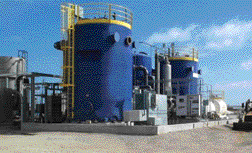 |
| According to Envirogen Technologies, its FBR system, pictured here, handles high flows at low cost with typical treatment efficiencies of 99% or higher. |
Envirogen Technologies and Inotec have entered into a joint technology development agreement to advance the performance of bioreactors in groundwater, mining water and a broad range of wastewater treatment applications. The initial focus of the development activity will be on reducing the amount of substrate (electron donor) required to successfully operate anoxic bioreactors as well as on minimizing the amount of solids generated.
Envirogen Technologies, an environmental technology and process solutions provider, is headquartered near Houston, Texas. Salt Lake City, Utah, USA-based Inotec is an environmental engineering and biotechnology company providing solutions for removing metals, inorganics and organic contaminants from industrial waters.
According to the two companies, bioreactor treatment operating costs are among the lowest of any type of water treatment technology on the market today—with electron donor and solids handling representing a significant portion of long-term project costs. Initial targets for technology development will be removal of metals and inorganics such as perchlorate, nitrate, sulfate, selenium, arsenic, mercury and more.
Dave Enegess, senior vice president for Envirogen, said the potential synergies for Envirogen’s fluidized bed reactor (FBR) and Inotec’s electro-biochemical reactor (EBR) technologies can be a boon for companies in need of high-performance, lower cost water treatment.
“This agreement is another step in our drive to push bioreactor technology to meet new challenges for treatment efficiency and cost-effectiveness,” said Enegess. “The goal here is first to be able to develop better solutions tailored to groundwater and wastewater treatment applications in mining, power, chemical and refining facilities, and potentially to develop revolutionary, next-step bioreactor technology,” he continued.
Envirogen describes its FBR as a fixed-film bioreactor in which biological media is suspended, or fluidized, within the reactor vessel by the upward flow of water through the system. High concentrations of biomass, its plug-flow characteristics, and tall beds minimize bioreactor footprint and shorten retention times. They offer steady-state performance without the need for backwashing, according to the company, and are tolerant of high feed total dissolved and suspended solids and metals.
Inotec’s EBR provides electrons to microbes in reactor environments using low-DC voltage potential (1-3 volts) and mA current in configurations that provide an electron density gradient or a controlled electron density. The provided electrons result in increased microbial contaminant transformation kinetics, reduced retention times, and reductions in the amount of nutrients and chemicals required for contaminant removal.
Inotec President D. Jack Adams noted that Envirogen has deployed more than 60 FBRs for groundwater and wastewater treatment, indicating the level of the company’s expertise. “The Envirogen team is a pioneer in fluidized bed bioreactor technology for water treatment,” he said. “Development of hybrid bioreactors, like an electro-biochemical fluidized bed reactor technology, holds considerable potential for more economical and more effective water treatment. The FBR process obtains one of the fastest contaminant removal kinetics, while the EBR technology consistently demonstrates metal and inorganics removals to low- and sub-ppb values.”






